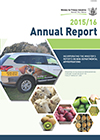Rock lobster on the East Coast and Mahia Peninsula is highly valued by commercial, recreational and customary fishers. The best estimate of harvest by amateur fishers in CRA 3 is from the 2011–12 National Panel Survey from a small number of respondents. This project investigates survey design options to robustly estimate rock lobster harvest by amateur fishers in CRA 3 over a fishing year. A variety of onsite and offsite methods are considered including hybrid surveys with a mix of methods.
Fifty trawl fishers were interviewed to record their knowledge of biogenic habitat, with charts being marked by the fishers before being digitised and collated. When these areas were overlaid together, a total of 65 sites were identified around the country where multiple fishers (up to 9) described the same or similar habitats at overlapping locations, or in close proximity. Of these 47 were suggested as “Key Sites” for consideration for future empirical sampling.
Surveillance is published as the Ministry for Primary Industries’ authoritative source of information on the ongoing biosecurity surveillance activity and the health status of New Zealand’s animal and plant populations in both terrestrial and aquatic environments. It reports information of interest both locally and internationally and complements New Zealand’s international reporting.

This document summarises MPI's achievements over the 2015/16 year and describes our performance in striving to reach our outcomes.
Agenda - Protecting to Grow New Zealand: Biosecurity Forum 2016
Using electronic monitoring to document snapper discards and validate catch effort data
Global Partnerships in Livestock Emissions Research (GPLER) Funding Round 4, 2016 successful pre-proposals summary
A trial of video observation in the SNA 1 trawl fishery collected footage from two cameras onboard each vessel. Footage was reviewed according to a standardised protocol and volumetric estimates of sub-MLS snapper weight made. These showed a high level of concordance with the catch estimates reported by the participating vessels under the SNX reporting code. The trial is considered to have been successful, providing a rich new source of information for use in management of the fishery.
MPI Technical Paper No: 2016/69
The Ministry for Primary Industries (MPI) New Zealand is actively involved in both international and domestic efforts to improve ship hull maintenance to minimise biosecurity risks but have recognised that more science is needed to inform the effectiveness of preventative tools and techniques to minimise ships’ biofouling, particularly for niche areas.
The “Biofouling Management Project” was therefore developed to identify effective hull maintenance practices to inform both shipping and regulatory authorities of activities that could constitute best practice. The aim of this project was to obtain information from a large number of vessels of different types, sizes and operational profiles from different locations throughout the world. Such sampling would encompass different antifouling systems and practices, different biofouling pressures, and different ship susceptibilities.
That application of a suitable antifouling coating system is the best method for minimising the establishment and growth of biofouling on hulls, hull appendages, and in sea chests and other wet-side niches. The type of coating that will be most effective varies for specific applications and, for any one vessel, several different coatings may be needed to achieve maximum protection.
Benefits for improved biofouling management, could be enhanced through widespread support from the shipping and paint industries to assess systems and generate additional information for comparison.
How valuable is that plant species? Application of a method for enumerating the contribution of selected plant species to New Zealand's GDP
This paper proposes amendments to the Dairy Industry Restructuring Act 2001 (DIRA) and the Dairy Industry Restructuring (Raw Milk) Regulations 2012 (Raw Milk Regulations), largely arising from the recent review of the state of competition in dairy markets. This paper also proposes new regulations for ongoing monitoring of dairy markets and technical amendments to the DIRA to recognise the change in management arrangements for the New Zealand Dairy Core Database that was agreed by Cabinet in 2014.
Prepared for MPI by Chris Pratt and Adrian Walcroft (Landcare Research), Andy Shilton, Benoit Buieysse and Matthew Chung (Massey University), and Rupert Craggs and Stephan Heubeck (National Institute of Atmospheric Research). Contract: 12215 (IR-H 13)
This Primary Growth Partnership newsletter informs stakeholders and interested parties about PGP activities while also profiling one of the current PGP programmes in each issue.
2011-2014 Antibiotic Sales Analysis